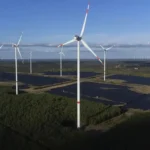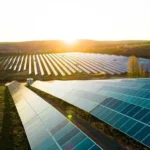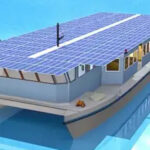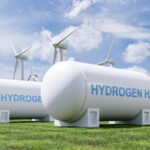What Are the 3 Main Types of Wind Turbines? | Horizontal & Vertical
Introduction
As the world shifts toward more sustainable energy solutions, wind energy is becoming an increasingly important source of renewable power. It is a clean, abundant, and environmentally friendly alternative to fossil fuels. Wind turbines are the primary technology used to harness this energy, converting the kinetic energy of wind into electrical power. As wind energy technology has advanced, different types of wind turbines have emerged, each designed to suit particular environments and purposes. Understanding the different types of wind turbines is crucial for those interested in wind energy, as each type has its unique advantages and applications.

This article aims to explain the three main types of wind turbines: Horizontal Axis Wind Turbines (HAWT), Vertical Axis Wind Turbines (VAWT), and Hybrid Wind Turbines. We will explore their designs, working principles, benefits, and common applications.
Section 1: Horizontal Axis Wind Turbines (HAWT)
Definition and Description
Horizontal Axis Wind Turbines (HAWT) are by far the most common and widely used type of wind turbines. These turbines are characterized by their horizontal rotor axis, meaning the blades rotate on a plane that is parallel to the ground. The rotor blades are mounted on top of a tall tower, and the turbine’s nacelle (housing for the generator and other components) is positioned at the top.
How HAWTs Work
In a typical Horizontal Axis Wind Turbine, wind flows through the rotor blades, causing them to spin. As the blades turn, they drive a generator housed in the nacelle, producing electricity. The nacelle also contains the gearbox, which helps convert the rotational speed into electricity at the required frequency. The tower provides the necessary height for the turbine, ensuring that it is positioned where the wind speeds are stronger and more consistent.
HAWTs operate best in environments where wind flows are steady and predictable, such as offshore or onshore locations. Offshore sites typically have higher wind speeds and fewer obstacles, making them ideal for large-scale HAWT installations. Onshore locations, such as fields or hilltops, also work well for HAWTs.
Advantages of HAWTs
One of the key advantages of Horizontal Axis Wind Turbines is their high efficiency. HAWTs are highly effective at capturing wind energy, especially when positioned in areas with consistent, strong winds. The large blades and high towers enable them to capture more wind, making them ideal for commercial-scale energy production.
Moreover, their design allows for easy scaling, meaning HAWTs can be installed in wind farms with dozens or even hundreds of turbines, contributing significantly to the grid. Their efficiency and ability to generate large amounts of power have made them the go-to choice for large-scale renewable energy projects.
Common Applications
HAWTs are typically found in both offshore and onshore wind farms. Offshore wind farms, due to the absence of obstacles like trees or buildings, offer ideal conditions for the large, powerful turbines to operate effectively. Onshore installations are often located in rural areas where land is abundant, and wind speeds are relatively high.
Section 2: Vertical Axis Wind Turbines (VAWT)
Definition and Description
Vertical Axis Wind Turbines (VAWT) have a rotor axis that is perpendicular to the ground, meaning the blades rotate on a vertical plane. Unlike HAWTs, the rotor is mounted on the bottom of the turbine, and the nacelle is located at the base. VAWTs are generally smaller and have a more compact design compared to HAWTs. The most common types of VAWTs are the Darrieus and Savonius designs, each with its distinct rotor configuration.
How VAWTs Work
In a Vertical Axis Wind Turbine, wind interacts with the blades, causing them to rotate around a vertical axis. As the blades turn, they drive a generator at the base of the turbine, converting mechanical energy into electrical energy. One of the defining features of VAWTs is that they can capture wind from any direction, meaning they do not need to be oriented into the wind as HAWTs do. This flexibility is a significant advantage in locations where wind directions are variable.
Advantages of VAWTs
Vertical Axis Wind Turbines offer several benefits compared to their horizontal counterparts. One of the primary advantages is their ability to operate in turbulent or gusty wind conditions. Since VAWTs can capture wind from any direction, they are less affected by changes in wind direction and can continue generating electricity even in less predictable environments.
Another key benefit is their quieter operation. VAWTs typically generate less noise than HAWTs, making them a suitable option for urban or residential environments where noise pollution is a concern. Additionally, their smaller size and more compact design make them easier to install in locations with limited space, such as rooftops or urban areas.
Common Applications
Vertical Axis Wind Turbines are ideal for urban environments, where buildings and other obstacles cause wind turbulence. Their ability to capture wind from any direction makes them particularly well-suited for locations with unpredictable wind patterns. VAWTs are also used in areas with limited space, such as rooftops or small-scale installations, where larger HAWTs would be impractical. While VAWTs are generally less efficient than HAWTs in terms of energy production, their versatility and quiet operation make them an appealing option for certain niche applications.
Section 3: Hybrid Wind Turbines
What Are Hybrid Wind Turbines?
Hybrid Wind Turbines combine the principles of both Horizontal Axis and Vertical Axis Wind Turbines. These turbines are designed to take advantage of the benefits of both systems, offering greater versatility and the potential for higher efficiency. Hybrid turbines typically feature a combination of vertical and horizontal blades or a hybrid rotor design that allows them to operate effectively in a variety of wind conditions.
How Hybrid Wind Turbines Work
Hybrid turbines often incorporate features from both HAWTs and VAWTs, such as dual rotors or blade configurations that allow for efficient energy capture regardless of wind direction. This flexibility makes hybrid turbines particularly well-suited for areas with fluctuating wind speeds or where wind direction is unpredictable. The combination of the two types of rotors can help optimize energy production, ensuring that the turbine performs well under a range of conditions.
Benefits of Hybrid Wind Turbines
One of the primary advantages of hybrid turbines is their increased versatility. They can capture energy more efficiently across different wind speeds and directions, making them suitable for locations with changing wind conditions. This adaptability can result in higher overall energy production compared to single-type turbines.
Hybrid turbines also offer a more robust solution for areas with fluctuating wind speeds. By combining the high efficiency of HAWTs and the flexibility of VAWTs, hybrid turbines can maintain consistent performance even in challenging environments. Additionally, they may have a smaller footprint than traditional HAWTs, making them ideal for installations in limited spaces or urban settings.
Common Applications
Hybrid wind turbines are typically used in areas where wind conditions are less predictable, such as regions with fluctuating wind speeds or where wind direction changes frequently. They are also ideal for small-scale applications, such as rooftop installations or remote locations where a reliable energy source is needed. These turbines can be used in both residential and commercial settings, offering a versatile and efficient solution for renewable energy production.
Conclusion
In conclusion, the three main types of wind turbines—Horizontal Axis Wind Turbines (HAWT), Vertical Axis Wind Turbines (VAWT), and Hybrid Wind Turbines—each offer unique advantages and applications. HAWTs are the most widely used turbines, known for their high efficiency and large-scale power generation capabilities, especially in offshore and onshore wind farms. VAWTs, on the other hand, offer flexibility, quieter operation, and suitability for urban environments and small-scale installations. Hybrid wind turbines combine the benefits of both HAWTs and VAWTs, providing greater versatility and efficiency for fluctuating wind conditions.
Choosing the right type of wind turbine depends on several factors, including location, wind conditions, available space, and energy requirements. By understanding the key differences between HAWTs, VAWTs, and hybrid turbines, you can make an informed decision that best suits your energy needs, contributing to a more sustainable and renewable energy future.
FAQs
1. What is the difference between Horizontal Axis Wind Turbines (HAWT) and Vertical Axis Wind Turbines (VAWT)?
The main difference between HAWTs and VAWTs lies in the orientation of their rotors. HAWTs have a rotor axis that is horizontal and are generally mounted on tall towers, while VAWTs have a vertical rotor axis and are typically smaller and mounted near the ground. HAWTs are more efficient for large-scale energy production, while VAWTs are better suited for smaller or urban installations due to their ability to capture wind from any direction and their quieter operation.
2. Are Vertical Axis Wind Turbines (VAWTs) as efficient as Horizontal Axis Wind Turbines (HAWTs)?
Generally, Horizontal Axis Wind Turbines are more efficient than Vertical Axis Wind Turbines because they can capture more wind energy due to their larger size and ability to operate in consistent wind conditions. However, VAWTs have the advantage of being able to operate in turbulent wind environments and can be installed in smaller spaces, making them suitable for niche applications, like urban or rooftop installations.
3. What are Hybrid Wind Turbines?
Hybrid Wind Turbines combine the principles of both Horizontal Axis and Vertical Axis Wind Turbines to offer increased versatility. They incorporate features from both designs, allowing them to perform efficiently in a variety of wind conditions and capture energy from multiple directions. Hybrid turbines are suitable for areas with fluctuating wind speeds and changing wind directions, offering greater efficiency and adaptability.
4. Where are Horizontal Axis Wind Turbines commonly used?
Horizontal Axis Wind Turbines are typically used in large-scale energy projects, both onshore and offshore. Offshore wind farms are ideal for HAWTs due to the consistent wind speeds and open spaces. Onshore installations are often found in rural areas or places with high wind speeds, where their efficiency in generating large amounts of power can be maximized.
5. Can Vertical Axis Wind Turbines be used in urban areas?
Yes, Vertical Axis Wind Turbines are ideal for urban environments. Their compact design and ability to capture wind from any direction make them suitable for locations with unpredictable wind patterns. Additionally, VAWTs operate more quietly compared to HAWTs, which reduces noise pollution—a significant advantage in residential or densely populated areas.











